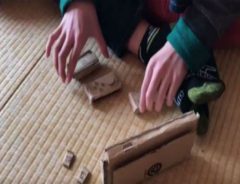Related Article
-

This Kid Made A Cardboard Nintendo Switch When His Mom Wouldn’t Buy Him One
-

3-D art bubbly scarf-wearing shiba inu glasses are your cutest drinking buddies
-

80-Year Old Tokyo Noodle Maker Teams Up With Hello Kitty For Pink Tonkotsu Ramen
-

Japanese Cat’s Mind Blown After His Favorite Mouse Toy Gets Washed
-

Most delicious Japanese Snacks to Buy this year if you are coming to Japan
-

Japan’s Mister Donut revamps introduces new sweet potato doughnut lineup



Photo credit: Connie Sceaphierde
Kyoto is perhaps best known for the traditional ancient atmosphere that you can experience by walking through its old streets. It is a living museum of Japan’s traditions where you can still catch glimpses of the past in the form of maiko scuttling through the streets, witness a performance of the historic art of Kabuki, experience an ancient form of tea ceremony in one of the classical wooden tea houses, and visit more temples than you ever thought you could. Kyoto is rich in Japanese culture, with numerous world heritage sites and over 2000 shrines and temples to explore.
Although to see all the temples in Kyoto, you will probably need a little longer than a week, one temple in particular can be found in the back pockets of anyone in Japan. Open up your wallet and take out a 10 yen piece, flip it over to the back and you will now be holding one of Kyoto’s ancient temples in the palm of your hand. The temple printed on the back of the 10 yen coin is the Hoo-do Hall of Byōdōin, an important piece of history that can still be visited today. Although it will cost a little more than 10 yen to get you there.
The temple is printed on the back of the Japanese 10 yen coin. Photo credit: Connie Sceaphierde
What you can find at the grounds of Byōdōin
Byōdōin is set back in the middle of a quaint and peaceful garden in the small traditional suburb of Kyoto, Uji. This small slice of Kyoto is internationally famed for its traditional tea cultivation, which to this day, still produces the most popular kind of green tea in Japan. The area is also home to the oldest stone bridge in Japan, which has been at the heart of countless horrific battles and clashes in Kyoto's history.
The temple was converted from a Fujiwara clan villa in 1052 to the buddhist sanctuary of Byōdōin. The temple’s Hoo-do hall, which translates into english as the phoenix hall, was built in 1053 which makes it the only remaining original building of the complex. The hall makes several references to the mythological phoenix, which was believed by the Japanese to be a protector of Buddha. There are two bronze phoenixes perched opposite each other on the roof of the building, and the architecture of the structure itself also represents the shape of the firebird.
Inside the hall sits a 2.4 meter tall statue of Amida Buddha and 52 smaller statues of Bodhisattvas which date back to the 11th century, and are said to have been carved by the famous heian era buddhist sculptor, Jocho. The hall is said to be an earthly representation of the buddha’s heavenly palace, and the surrounding gardens and grounds are meant to mirror the paradise of the pure lands in Japanese Buddhism. Over the centuries the majority of the original buildings were continuously lost in fires and battles, however, the Phoenix hall has continued standing, which makes it one of the only remaining examples of Heian period architecture in Japan.
After paying the entrance fee, you will be free to explore the well kept traditional Japanese gardens of Byōdōin. Aside from the main Phoenix hall, there are a few other buddhist structures as well as the grave of the famous samurai warlord Minamoto-no-Yorimasa inside the temple grounds. After being defeated in battle Minamoto-no-Yorimasa commited suicide in the precinct of Byōdōin temple. This famous suicide is believed to have been the first seppuku suicide commited by a samurai in the history of Japan.
Standing proudly on a small island in the centre of the complex, is the Phoenix hall, which takes a beautiful picture when it is reflected in the glistening emerald water of the temple’s ponds.
Following the path through the grounds of Byōdōin, you will come across the entrance to the Homotsukan Treasure House just behind the Phoenix hall. This treasure house is a museum attributed to the history of Byōdōin, and contains the original temple bell and door paintings of the temple complex as well as the original phoenix roof sculptures and tiles. The majority of the museum is constructed underground so as not to disturb the view of the Phoenix hall.
The phoenix hall of Byōdōin makes a good photo when it reflects in the water. Photo credit: Connie Sceaphierde
How to get to Byōdōin Hoo-do
The old town of Uji can be reached by taking a 40 minute train ride on the Keihan Uji line or the JR Nara line from Kyoto Station. If you are planning to see the ancient Uji Bridge as well as Byōdōin Hoo-do, take the Keihan Uji line. Exiting the station, you will come outside at the bank of the Uji river. The main bridge here is the ancient stone Uji Bridge. After taking in the wide expanse of the river, cross over and turn left to find Byōdōin. Alternatively, Byōdōin temple is 10 minutes east on foot from JR Uji station.
Basic entrance to the garden and treasure house cost 600 yen, and for an additional fee of 300 yen, you can take a tour of the inside of the phoenix hall.